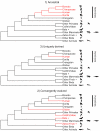The function and evolution of child-directed communication
- PMID: 35522717
- PMCID: PMC9116647
- DOI: 10.1371/journal.pbio.3001630
The function and evolution of child-directed communication
Abstract
Humans communicate with small children in unusual and highly conspicuous ways (child-directed communication (CDC)), which enhance social bonding and facilitate language acquisition. CDC-like inputs are also reported for some vocally learning animals, suggesting similar functions in facilitating communicative competence. However, adult great apes, our closest living relatives, rarely signal to their infants, implicating communication surrounding the infant as the main input for infant great apes and early humans. Given cross-cultural variation in the amount and structure of CDC, we suggest that child-surrounding communication (CSC) provides essential compensatory input when CDC is less prevalent-a paramount topic for future studies.
Conflict of interest statement
The authors have declared that no competing interests exist.
Figures


Similar articles
-
Becoming human: human infants link language and cognition, but what about the other great apes?Philos Trans R Soc Lond B Biol Sci. 2020 Jan 6;375(1789):20180408. doi: 10.1098/rstb.2018.0408. Epub 2019 Nov 18. Philos Trans R Soc Lond B Biol Sci. 2020. PMID: 31735145 Free PMC article. Review.
-
When and how do non-human great apes communicate to support cooperation?Philos Trans R Soc Lond B Biol Sci. 2022 Sep 12;377(1859):20210109. doi: 10.1098/rstb.2021.0109. Epub 2022 Jul 25. Philos Trans R Soc Lond B Biol Sci. 2022. PMID: 35876197 Free PMC article. Review.
-
Vocal-gestural combinations in infant bonobos: new insights into signal functional specificity.Anim Cogn. 2019 Jul;22(4):505-518. doi: 10.1007/s10071-019-01267-0. Epub 2019 May 16. Anim Cogn. 2019. PMID: 31098849
-
The role of exploration and exploitation in primate communication.Proc Biol Sci. 2025 Jan;292(2039):20241665. doi: 10.1098/rspb.2024.1665. Epub 2025 Jan 22. Proc Biol Sci. 2025. PMID: 39837521 Free PMC article. Review.
-
Considering the role of social dynamics and positional behavior in gestural communication research.Am J Primatol. 2013 Sep;75(9):891-903. doi: 10.1002/ajp.22151. Epub 2013 Apr 5. Am J Primatol. 2013. PMID: 23564649 Review.
Cited by
-
Meaning in Music Is Intentional, but in Soundscape It Is Not-A Naturalistic Approach to the Qualia of Sounds.Int J Environ Res Public Health. 2022 Dec 24;20(1):269. doi: 10.3390/ijerph20010269. Int J Environ Res Public Health. 2022. PMID: 36612591 Free PMC article. Review.
-
The evolution of infant-directed communication: Comparing vocal input across all great apes.Sci Adv. 2025 Jun 27;11(26):eadt7718. doi: 10.1126/sciadv.adt7718. Epub 2025 Jun 25. Sci Adv. 2025. PMID: 40561040 Free PMC article.
-
Bottlenose dolphin mothers modify signature whistles in the presence of their own calves.Proc Natl Acad Sci U S A. 2023 Jul 4;120(27):e2300262120. doi: 10.1073/pnas.2300262120. Epub 2023 Jun 26. Proc Natl Acad Sci U S A. 2023. PMID: 37364108 Free PMC article.
-
Temporal patterns in the complexity of child-directed song lyrics reflect their functions.Commun Psychol. 2025 Mar 24;3(1):48. doi: 10.1038/s44271-025-00219-4. Commun Psychol. 2025. PMID: 40128378 Free PMC article.
-
Social Brain Perspectives on the Social and Evolutionary Neuroscience of Human Language.Brain Sci. 2024 Feb 7;14(2):166. doi: 10.3390/brainsci14020166. Brain Sci. 2024. PMID: 38391740 Free PMC article. Review.
References
-
- Golinkoff RM, Can DD, Soderstrom M, Hirsh-Pasek K. (Baby) Talk to me: The social context of infant-directed speech and its effects on early language acquisition. Curr Dir Psychol Sci. 2015;24(5):339–44. doi: 10.1177/0963721415595345 - DOI
-
- Holzrichter AS, Meier RP. Child-directed signing in American sign language. In: Chamberlain C, JPM C, Mayberry RI, editors. Language acquisition by eye. Hillsdale, NJ: Lawrence Erlbaum Associates; 2000. p. 25–40.
-
- Masataka N. Motherese in a signed language. Infant Behav Dev. 1992;15(4):453–60. doi: 10.1016/0163-6383(92)80013-K - DOI
-
- De Boer B. Infant-directed speech and the evolution of language. In: Tallerman M, editor. Evolutionary prerequisites for language. Oxford: Oxford University Press; 2005. p. 100–121.
Publication types
MeSH terms
LinkOut - more resources
Full Text Sources

